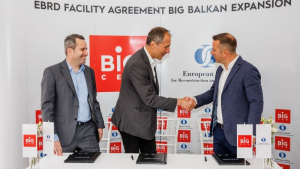
Piotr Staniszewski, Partner, Real Estate, Dentons talked to Property Forum about the awareness of the PRS investors in Poland, planned legislative changes and the current financing conditions.
According to your recent report, compiled with Knight Frank, the Polish PRS market grew by as much as 40% in 2022. In 2023, the industry will probably not be able to sustain such an impressive growth rate.
We noticed a general slackening pace in transactions in 2023. In fact, so far, 2023 is running at a record low in transactions not only in Poland but in Europe generally. If we think about the PRS market from the vantage point of announced acquisitions, this slowdown will also be observed in this sector throughout 2023. The PRS market, however, benefits from the fact that a number of forward transactions closed in 2021 and 2022 and the product will be delivered to the market in 2023 and 2024. So, from this perspective, this segment will develop in the coming months, as the apartment portfolios will grow and new residential units will be leased-up by end users.
High interest rates in the eurozone, the government's plans to tax portfolio purchases of apartments, and the lack of a suitable product - what are the most important factors currently holding back the development of institutional rental in Poland?
All of these factors combined currently represent an obstacle to the growth of the institutional rental market in Poland. The taxation plans have not come to fruition yet, however, politics, especially in the year of elections, is a contributory factor. Importantly, the Polish market of individual buyers is recovering, driven by the relaxation of creditworthiness rules and the government’s new program to support mortgage buyers with fixed, low-interest rates. These factors contribute to limited product offers for acquisitions by the institutions, as typically individuals buy apartments with higher margins for the developers’ benefit. Uncertainty about availability and the cost of financing are also relevant. In particular, construction costs did stabilize recently, but still remain high, not least due to the high inflation rate. On the other hand, institutional operators are still expanding their apartment bases and some actors from different sectors (retail or office) diversify their portfolios to include PRS products. So, despite obstacles, we see the market trying to expand and grow the PRS asset class.

Piotr Staniszewski
Partner
Dentons
How is the investment attractiveness of our PRS sector affected by the prolonged conflict in Ukraine?
The war in Ukraine introduced an additional layer of uncertainty into the markets. Unavoidably, many analysts factored in the proximity of Poland to the conflict zone which had an initial chilling effect. But with the successes of the Ukrainian army fighting against the Russian aggressor, things now seem to be moving (albeit slowly) in a more favourable direction for Poland and we see business continuing to flourish despite the uncertainty. For the apartment rental market the influx of war refugees, in particular in the initial phase of the war, resulted in soaring occupancy ratios. Recently, the Ukrainian population remaining in Poland stabilized, however, the rental market is still more the landlord’s market and will stay that way in the coming months. It may be reasonably assumed that some Ukrainian families will stay in Poland, even after the war is over. However, there is still an estimated shortage of approximately 800,000 units in the country. This gap will be difficult to close and will require large investments from all market operators, active both in traditional build-to-sell as well as in more recent built-to-rent models.
And what will stimulate its development, apart from, of course, the continuing low creditworthiness of Poles and their migration from the property market to the rental market?
In order to stimulate the market, more opportunities for land development should be created. In the legislative pipeline, we have a draft law allowing for the conversion of obsolete shopping centres or office developments into residential schemes. Increased availability of land, together with local municipalities understanding the need for deployment of residential investments, should stimulate the market. However, Poland has been struggling with a shortage of apartments for a very long time, going back as far as the 1920s. This proves that the reasons for this situation are systemic, and to some extent also relate to Polish sentiment connected with house or apartment ownership rather than renting it, as well as the limited availability of local capital which could be put to build-to-rent purposes. In general, I think that a factor which could positively change the situation would be the introduction of REITs into the Polish market landscape. Unfortunately, the legislation in this area has been contemplated several times, but without much progress. It remains to be seen whether this subject is picked up in the current election campaign or by the established post-election government.
Warsaw and Kraków are obvious positions on the PRS map of Poland. Which cities do you think can challenge these two in the future?
Poland has a number of relatively large, modern cities with good universities and robust businesses. The PRS market started with the most obvious and safest choices of Warsaw and Kraków, but in the future, we can see it expanding to Wrocław, Silesia’s metropolis of Katowice and ”the Tri-City” of Gdańsk-Sopot-Gdynia. We can observe shortages of quality apartments for rent in practically all Polish regions. Obviously, rent levels will be lower in eastern Poland, but the rental market is even more saturated there, so perhaps in the future, we will experience the market expanding to Bialystok, Przemyśl and Rzeszów too.
And how do you assess the current willingness of banks to finance large portfolio investments?
In principle, we observe a slowdown in the financing market. However, large portfolio investments are not currently traded mainly because of the uncertainty of pricing. The re-evaluation of real estate assets is a process which already commenced in 2022 and does not seem to be completed yet. The stability of yield expectations is crucial for the market and especially so for large, high-value transactions. With high-interest rates, the costs of undertaking such transactions with external financing are prohibitive for most of the players. So, in other words, it is not the willingness of financial institutions, but rather high financing costs, which impede large transactions from the economic point of view. The PRS market is in an even more complicated position, as there have been no large portfolio transactions in operating assets in Poland yet, therefore the market lacks an important pricing benchmark.



